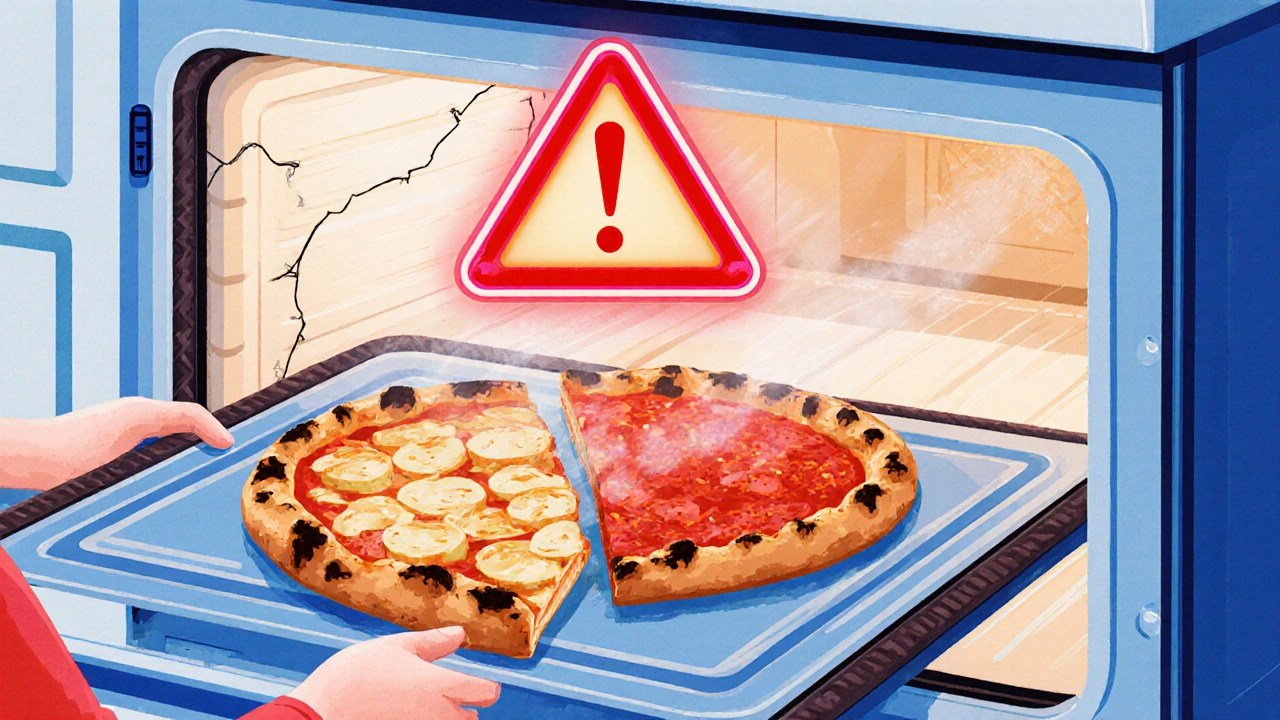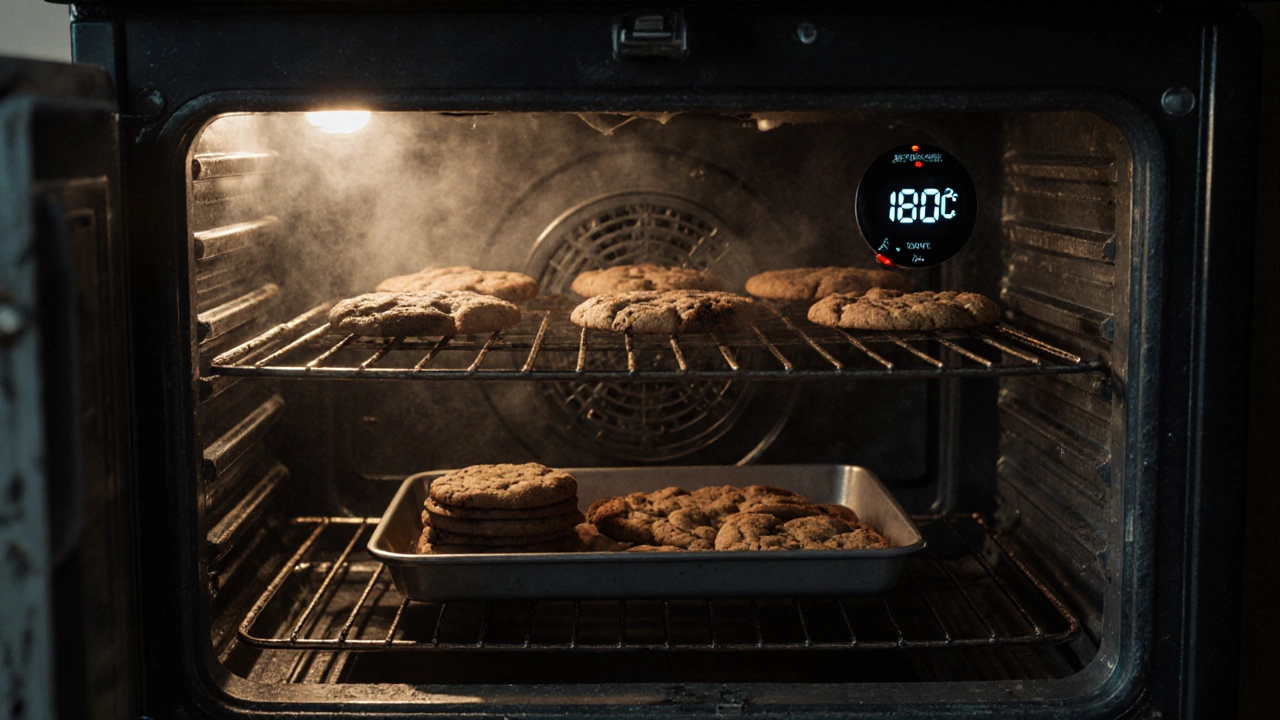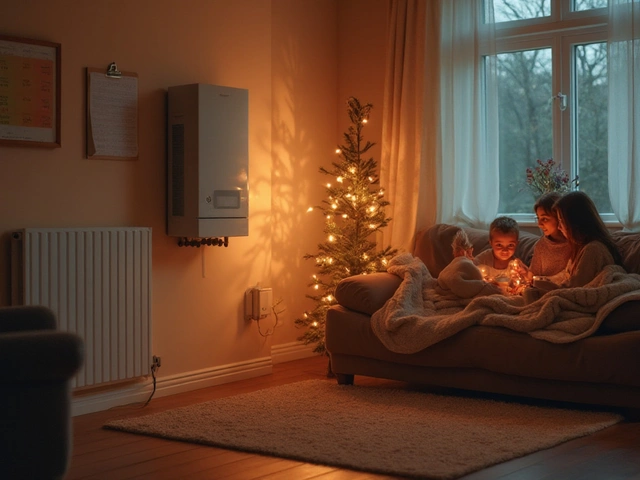Oven Replacement Calculator
How long does your oven last? If you’re still using the same one from when you moved into your house ten years ago, you might be wondering if it’s time to replace it-or if you can just fix it again. The truth is, ovens don’t just suddenly die. They give you signs. Quiet ones. Frustrating ones. And if you ignore them, you end up with unevenly cooked food, higher electricity bills, or worse-a fire hazard.
Your oven is taking longer to heat up
If your oven used to hit 180°C in 10 minutes and now it’s taking 25, something’s wrong. This isn’t just slow performance-it’s a sign the heating element is weakening or the thermostat is failing. You might notice the oven light turns on, but the inside stays cold for ages. Or maybe the preheat beep comes on, but when you open the door, your roast is still raw in the middle.
Electric ovens rely on two main heating elements: the top broil element and the bottom bake element. Over time, these wear out. You can check them visually. Turn off the power, pull the oven out, and look at the elements. If they’re discolored, cracked, or have big gaps where the coil used to be tight, they’re done. Replacing them costs around $150-$250 in Brisbane. But if both elements are failing, or if the control board is glitchy, it’s usually cheaper to replace the whole oven.
Temperature is all over the place
Ever baked cookies and half are burnt while the others are doughy? Or roasted chicken that’s charred on the outside and icy inside? That’s not your recipe. That’s your oven.
A good oven holds temperature within ±5°C. If yours swings 20°C or more, the thermostat is broken or the sensor is dirty. You can test it with an oven thermometer-put one on the middle rack, set the oven to 180°C, and check after 20 minutes. If it reads 160°C or 205°C, it’s not accurate. Cleaning the sensor (a thin metal rod near the back wall) sometimes helps. But if cleaning doesn’t fix it, and you’ve had this issue for more than a year, the control system is aging. Newer ovens use digital sensors and PID controllers that adjust heat in real time. Older models? They’re basically on/off switches. That’s why your food never cooks evenly.
Uneven cooking or hot spots
Hot spots are normal in cheap ovens. But if your oven used to cook evenly and now it doesn’t, that’s a red flag. One side of your pizza is charred, the other raw? Your bake element might be failing. Or the fan in a convection oven has stopped spinning properly. If the fan motor is noisy or doesn’t spin at all, airflow is broken. That means heat doesn’t circulate. You’re not just getting bad results-you’re wasting energy.
Try the toast test: place slices of bread on each rack and bake at 180°C for 10 minutes. If one slice is black and another is pale, your oven’s heat distribution is uneven. This happens when the heating element is partially burnt out or the fan blades are clogged with grease. Cleaning helps temporarily. But if it’s happening more often, the oven’s internal design is failing. Newer ovens have multiple sensors and forced-air systems that balance heat. Your old one doesn’t.
The oven door doesn’t seal properly
Check the door seal. It’s the rubbery strip around the door frame. If it’s cracked, brittle, or peeling off, heat escapes. You’ll feel it when you stand near the oven-it’s warmer than it should be. You might even notice the kitchen getting hotter during cooking.
A broken seal means your oven has to work harder to maintain temperature. That spikes your electricity bill. A good seal keeps heat in and keeps the outside cool. Replacing the gasket costs $40-$70. But if the door itself is warped, the hinges are loose, or the latch doesn’t click shut, the whole door assembly is worn out. You can’t fix that with a new gasket. And if the glass in the door is cracked or foggy inside, it’s not just an eyesore-it’s a safety risk. Glass in oven doors is tempered for high heat. Cracks can spread under temperature stress. Replace the door or the whole oven. No exceptions.

Excessive noise or strange smells
Ovens aren’t silent. But they shouldn’t sound like a jet engine or smell like burning plastic. If you hear loud buzzing, clicking, or grinding noises when the oven turns on, something’s wrong with the fan motor, relay, or control board. A single click when it turns on is normal. Constant clicking? That’s the relay trying and failing to engage the heating element.
Smells are worse. A new oven smells like plastic for the first few uses-that’s normal. But if you’ve had your oven for five years and suddenly you smell burning insulation, ozone, or metal, stop using it. That’s not food residue. That’s wiring overheating or components melting. One of my clients in Toowong had an oven that smelled like burnt toast every time it turned on. Turns out, the insulation around the wiring had degraded. The wires were arcing inside the wall. That’s a fire waiting to happen.
High energy bills with no change in usage
Did your electricity bill jump 20-30% this year? And you didn’t start baking more? Your oven could be the culprit. Older ovens use 2-3 kW per hour. Modern ones use 1.5-2 kW. That’s a 25-40% drop in energy use. If your oven is over 12 years old, it’s likely running inefficiently. Even if it heats up, it’s doing it the hard way-struggling to maintain temperature, cycling on and off too often, leaking heat.
Look at your bill over the last 12 months. If the spike started right after a repair, that’s a clue. Replacing a thermostat or element doesn’t fix inefficiency. It just buys you a few more months. An oven that’s 15+ years old is using outdated tech. Newer models have energy ratings (A+ to A+++ in Australia). A 2025 model uses 30% less power than a 2010 model. That adds up to $100-$150 a year in savings. Payback? Less than three years.
Repeated repairs in the last two years
Here’s a simple rule: if you’ve spent more than half the cost of a new oven on repairs in the last two years, replace it. That’s not a suggestion-it’s a financial fact.
Let’s say your oven cost $800 new. You paid $300 to replace the element last year, $200 for the thermostat this year, and $150 to fix the fan motor six months ago. That’s $650 spent. You’re now at 81% of the original cost. A new oven costs $700-$1,200. You’re already close to that number. And the next repair? It could be the control board-$400 to fix. That’s $1,050 spent on a 14-year-old appliance.
Warranties on ovens last 1-2 years. After that, repairs are on you. And parts for older models? They’re harder to find. Some brands stop making parts after 8-10 years. If your oven is from a brand that doesn’t exist anymore, good luck finding a replacement element. That’s not repairable. That’s a replacement job.

The oven is outdated or doesn’t fit your needs
Maybe your oven still works. But does it work for you? If you’re trying to air fry, bake sourdough, or use smart features like remote preheating, your 2012 model won’t help. New ovens have convection modes, steam functions, delay timers, and Wi-Fi controls. They’re designed for how people cook now.
Also, size matters. If your oven is too small for your family or too big for your kitchen, it’s not just inconvenient-it’s inefficient. A 60L oven uses more energy than you need if you only cook for two. A 40L oven struggles if you host dinners. Modern ovens come in compact, standard, and large sizes. You can get a 60cm wide oven that fits your space but has 70L capacity thanks to better insulation and design.
And what about cleaning? If you’re scrubbing baked-on grease every month, you’re wasting time. New ovens have pyrolytic self-cleaning modes. They heat to 500°C and turn grease into ash. You wipe it out with a cloth. No chemicals. No scrubbing. That’s not a luxury-it’s a time-saver.
When to replace vs. repair: a quick guide
- Replace if: Oven is over 12 years old, repair costs exceed 50% of a new unit’s price, heating elements or thermostat keep failing, door seal is damaged, energy bills are rising, or it’s unsafe (smells, sparks, overheating).
- Repair if: Oven is under 8 years old, only one part is broken (like a single element), the repair is under $200, and the model still has available parts.
Most people wait too long. They think, “It still works.” But it’s not working well. And the longer you wait, the more you pay in wasted energy, ruined meals, and stress.
What to look for in a new oven
When you’re ready to replace it, focus on these features:
- Energy rating: Look for A+++ in Australia. Avoid anything below A+.
- Capacity: 60-70L is ideal for families. 40-50L for couples or small kitchens.
- Convection: A fan that circulates heat makes cooking faster and more even.
- Self-cleaning: Pyrolytic cleaning is the best. Avoid steam-only cleaning-it doesn’t handle heavy grease.
- Warranty: At least 2 years on parts and labor. Some brands offer 5 years on the heating elements.
Brands like Bosch, Miele, and Smeg have good reliability scores in Australia. But even mid-range brands like Westinghouse and Electrolux have improved a lot in the last five years. Don’t buy the cheapest one. Don’t buy the most expensive one. Buy one that fits your cooking habits.
And don’t forget to measure your space. Ovens have exact cut-out dimensions. If you’re replacing a 60cm oven, you need a 60cm replacement. Otherwise, you’re looking at cabinetry changes-and that adds $1,000+ to the job.
Final thought
Your oven isn’t just an appliance. It’s part of your daily life. If it’s letting you down, it’s not worth the hassle. Replacing it isn’t a luxury-it’s a smart investment in time, safety, and money. The signs are there. You just have to listen.
How long should an electric oven last?
Most electric ovens last between 10 and 15 years with normal use. Factors like how often you use it, whether you clean it regularly, and if it’s properly ventilated can extend or shorten that lifespan. Ovens older than 15 years are typically inefficient and prone to repeated failures.
Is it worth repairing an oven that’s 10 years old?
It depends on the repair cost. If the fix is under $200 and the oven still heats evenly and seals well, yes. But if you’re replacing the control board, heating elements, or thermostat more than once in two years, replacement is more cost-effective. After 10 years, parts become harder to find and energy efficiency drops significantly.
Can a faulty oven cause a fire?
Yes. Faulty wiring, overheating elements, or damaged insulation can cause electrical fires. If you smell burning plastic, see sparks inside the oven, or notice the exterior getting unusually hot, turn off the power at the circuit breaker and stop using it immediately. These are serious warning signs.
How much does it cost to replace an oven in Brisbane?
A standard built-in electric oven in Brisbane costs between $700 and $1,500, depending on size, features, and brand. Installation usually runs $150-$300. High-end models with smart features or steam functions can cost up to $3,000. Always get a quote that includes removal of the old unit and disposal.
Do I need a professional to install a new oven?
Yes. Electric ovens require a dedicated 240V circuit and proper grounding. Installing one yourself risks electrical hazards or voiding the warranty. A licensed electrician should handle the wiring, and a qualified appliance technician should ensure it’s level, vented correctly, and safely connected.





